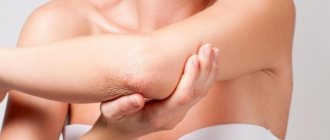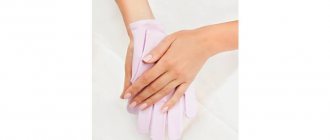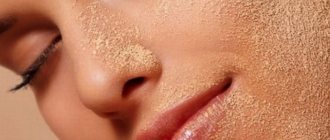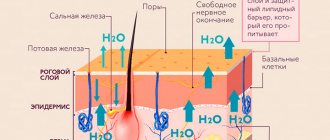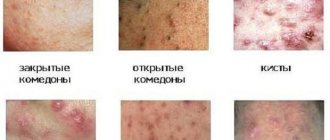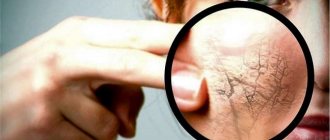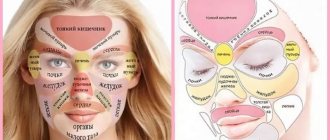Peeling skin on the chin. When should you see a doctor?
In medicine, this phenomenon is called “perioral dermatitis” - redness of the dermis, characterized by localized peeling on the chin and around the mouth.
Initially, many small bubbles form, which then begin to itch and peel. If a red spot appears on your chin, you need to exclude the allergen. Often these are cosmetics containing sodium sulfate, paraffin, petroleum jelly or fragrances. If the stain does not disappear, but, on the contrary, from a single rash has spread to the folds of the mouth and nasolabial triangle, you should immediately consult a doctor.
A dermatologist treats this problem. First, a visual examination is carried out, and then a histological analysis of the skin is prescribed (for this, a scraping is taken from the damaged area of the dermis).
Attention! Peeling skin on the chin is the exfoliation of dead keratinized cells from the top layer - the epidermis. This indicates a disruption in the process of replacing old cells with new ones. The size and appearance of peeling indicate its type: pityriasis, scaly, small- and large-lamellar.
In the photo you can see how isolated red spots initially appeared on the chin. In this case, peeling may have a heterogeneous texture and color (from white to bright red). Also, dryness is sometimes preceded by purulent and watery formations, painless nodes under the skin and local pigmentation. The photo shows that there is a clear boundary between healthy dermis and flaky dermis. Lack of timely treatment leads to the spread of peeling to the forehead, cheeks and nose.
Symptoms
The signs and symptoms of dry skin on your chin or face depend on your age, where you live, your health, and how much time you spend outdoors.
Possible associated symptoms of dry skin on the chin include:
- A feeling of tightness, especially after showering, bathing, or swimming
- Rough skin
- Itching
- Slight flaking, peeling
- Cracks or thin depressions in the face
- Grey, ash color
- Redness
- Deep bleeding cracks
The skin on the chin turns red and peels. Traditional medicine recipes against peeling
Oatmeal scrub is an excellent remedy for removing peeling on the chin
If peeling is caused by external factors, then time-tested recipes from traditional medicine will help improve the condition.
First, you should cleanse the skin of the stratum corneum to get the maximum effect from the procedure. Cleansing occurs using a scrub. You should not use scrubs containing abrasive substances, because... this will only worsen the situation and injure the skin. It would be ideal to use gommages and scrubs made independently at home. How to use the scrub correctly, read the article.
Oatmeal scrub 2 tbsp. Pour boiling water over the flakes and leave for 20 minutes, then add the white of 1 egg to the resulting mass, mix well. Apply the resulting composition to the face with massage movements, leave for 5-10 minutes and rinse with warm water.
Berry scrub Grind a handful of blackberries in a mortar, spread the mixture over the face with massage movements for several minutes, then wash with water.
Also, for facial peeling at home, you can use coffee grounds, pieces of apple, cucumber or watermelon, which should be used to wipe your face strictly along the massage lines. A piece of bread soaked in milk is also suitable as a cleansing agent. The resulting paste should be applied to the face for 20 minutes, then rinsed off with cold water.
To remove flaky, dead cells, you can perform the following procedure: mix honey in water and massage the previously cleansed facial skin, wetting your fingers in the resulting composition during the procedure. Then the face should be rinsed with warm water, blotted and applied with a cream suitable for your skin type.
Remember that if the skin on your chin is peeling, you need to take more careful care of the skin.
Diagnostic technique
Correct treatment and choice of medications can be made only after identifying the main type of fungus that provoked mycosis of the facial hair growth area. A dermatologist takes skin particles and fluids for analysis in a laboratory setting, which allows them to grow colonies and understand the root cause.
The basis of parasitic sycosis is always infection with a fungus, to which staphylococcus is attached. Therefore, in addition to identifying the type and type of pathogen, a study is carried out for resistance to antibiotics. This helps you choose the right treatment options. Additionally, beard hair tests and several skin tests with trichophyton are carried out.
Infection with zoophilic species of dermatophytic fungi is more often detected in people living in urban settlements, villages, hamlets and among workers on livestock farms. The problem associated with anthropophilic fungi can arise from poor hygiene of shaving accessories and contact with a sick person.
The skin around the nose and eyebrows is peeling. Why does peeling occur?
The main factors that cause the skin to peel are polluted air and water. In combination with improper hygiene, during which aggressive chemicals are used, symptoms of skin damage are noted.
There are a number of dermatological pathologies in which peeling is a normal phenomenon. The most common is ichthyosis, a genetic disease that is not fully known to doctors and medicine.
When the disease occurs, the skin dries out and cracks throughout the body. A person is tormented not only by the exfoliation of dead cells, but also by severe itching. In this case, the integument changes shade to gray-white, becoming covered with pearlescent or pink scales.
The skin most often peels off when the body is affected by various pathologies.
With ichthyosis, the epidermis is in a constantly inflamed state. Even with minor damage, the process is complicated by purulent dermatitis.
The causes of peeling skin on the body may be associated with other pathologies. Among them are:
- seborrhea;
- psoriasis;
- systemic lupus erythematosus;
- dry erythema;
- pityriasis rosea.
Similar symptoms are also observed with fungal infection. Especially often in this case, the skin around the mouth peels off. In addition, the doctor must exclude chronic pathologies of internal organs and secondary syphilis.
Various types of dermatitis deserve special attention. This condition can be provoked by contact, atopic and allergic forms. They are characterized by increased formation and accumulation of dead cells.
The skin on the eyebrows, chin, and nose often peels off due to external influences on it. Women use lotions and tonics containing alcohol and perform peelings. The sun's rays have a negative impact. Even simple cosmetics can cause peeling. Dried skin begins to reject scales from the surface.
Peeling of the skin around the mouth can appear as a result of vitamin deficiency. The body feels a lack of vitamin A. Additionally, symptoms may appear in the form of purulent rashes and drying of the mucous membranes of the eyes.
A similar condition occurs with a lack of vitamin B2. In this case, the skin on the forehead, ears, cheeks and nose peels off. Cracks also appear in the corners of the mouth, and the tongue changes color to purple.
The skin can peel off due to a lack of vitamins in the body.
The skin around the eyes, on the cheeks, and throughout the body peels especially often due to hormonal changes. Female sex hormones and active substances produced by the thyroid gland change the condition. If their deficiency is noted, and they themselves cannot be produced, the integument loses its elasticity.
Hypothyroidism is one of the most common hormonal diseases. In this case, the level of hormones decreases sharply. Women note that the skin around the nose, eyebrows and lips becomes dry and flabby during menopause.
Prognosis and prevention
The prognosis for mycosis affecting the skin of the beard is good. Prevention of the development of mycoses involves eliminating risk factors:
- It is strictly not recommended to pick up or pet stray dogs or cats;
- If you suspect a fungal infection in your pets, you should contact your veterinarian. If suspicions are confirmed, the sick animal should be isolated until complete recovery.
- It is not recommended to use other people's shaving accessories, towels and other hygiene items. In hairdressing salons, shaving instruments, scissors and combs must be placed in the sterilizer after each client.
- If there is a person with mycosis in the family, it is necessary to provide him with separate hygiene items and thoroughly disinfect them after use.
Fungus on beard photo
One of the serious pustular skin diseases is mycosis, which affects the area of beard and mustache growth. Among specialists, it is called “infiltrative-suppurative trichophytosis of the mustache”, and more often – “parasitic sycosis”. This type of mycosis is an inflammation of the hair follicles on the face caused by certain types of fungi.
The skin on the chin has darkened. Why your chin may turn red
The most common cause of redness of the skin in the chin area is acne, that is, acne. In most cases, teenagers suffer from this, since during the restructuring of the body there is a sharp change in hormonal levels, as well as activation of the sebaceous and sweat glands. Often a red chin is a sign of allergies. It can be caused by many factors: pollen, microscopic mites living in house dust, certain foods, drinks, medications, ultraviolet radiation, etc.
An allergic reaction is usually accompanied by itching. It can be both moderate and severe, causing noticeable discomfort.
Red spots on the chin may appear due to certain skin diseases. For example, such spots are a typical example of the disease rosacea, the causes of which have not yet been clarified by doctors. It is only known that this is a non-infectious inflammatory disease that mainly affects middle-aged and elderly people. Treatment for this disease is very long and not always effective.
It is most often suffered from in Scandinavian countries, where signs of this disease occur in approximately 10% of the population.
The chin may also become red due to the expansion of capillaries located directly at the surface of the skin. In addition, red spots can be a sign of scleroderma, a connective tissue disease. Such spots become lighter and denser over time.
Mycosis of the beard and mustache: treatment
Synthomycin ointment for nail fungus
Therapy for mycotic lesions of the facial hair growth area is usually quite long. It includes a combination of treatment of fungal and staphylococcal pathogens using different methods. All appointments are made by a qualified dermatologist or mycologist. In case of exacerbation of internal diseases, consultation with a surgeon, neurologist or urologist is necessary.
To relieve skin inflammation and reduce the secretion of pus, it is recommended to treat the chin several times a day alternately:
- syntomycin ointment;
- gentamicin solution;
- a mixture of boric acid and potassium permanganate.
This helps reduce the exacerbation and move on to the main antimycotic treatment. The patient takes antibiotics orally or by injection:
- Oxytetracycline;
- Chlortetracycline;
- Augmentin;
- Cephalexin.
Additional intake of these drugs helps to effectively fight staphylococcus from the inside. The course of treatment can be up to three weeks and is constantly accompanied by monitoring the patient’s health.
In parallel, antifungal therapy is carried out using local and internal medicines. To treat trichophytons that cause mycosis of the beard and mustache, dermatologists use:
- Ketonazole;
- Fluconazole;
- Itraconazole capsules;
- Griseofulvin.
They can be used in the form of light emulsions and creams. Beforehand, the hair must be trimmed as much as possible; shaving is strictly prohibited during an exacerbation and treatment. Applications of an antifungal composition can be combined with skin treatment with an alcohol solution of regular iodine.
A good addition to the main treatment is irradiation of the affected areas of the skin with ultraviolet radiation and doses of ultraviolet radiation on purulent wounds. The patient should take a course of multivitamins and immunostimulants that help the body cope with the disease faster.
Peeling skin disease. Peeling skin
Who to contact: dermatologist.
Peeling of the skin is a normal physiological process. When the skin is severely dry, for any reason, it begins to peel off and small or larger scales appear.
Causes
Peeling of the skin may increase during the cold season, which is associated with low atmospheric humidity and heating of the premises; under the influence of frequent washing with harsh soap; in older people, due to decreased function of the sebaceous glands, the skin dries faster.
Dry and flaky skin may be accompanied by the following skin problems and diseases:
· various damage to the skin;
· skin irritations;
· inflammation as a result of sunburn;
· allergic reactions;
· the effects of poison ivy toxins;
- If peeling skin is accompanied by severe itching.
- If peeling skin is complicated by inflammation or infection.
- If you notice the appearance of fish scale-like skin (even if it is not itchy at first) on your lower legs.
- If your home treatment has not been successful after three weeks.
Home remedies for flaky skin.
Many factors contribute to peeling skin, but treatment requires one thing: moisturizing. To reduce skin flaking, you can try the following methods:
· use soft, high-fat soaps or shower gel for washing;
· after the bath, you need to dry your skin thoroughly, blotting it with a towel rather than rubbing it, so as not to cause irritation;
· After washing, apply moisturizing cream with olive oil to the entire body;
· Wear smooth, organic cotton clothing to avoid irritation.
Causes
Potential causes of it appearing on the chin include:
Weather
Skin tends to be dry in winter when temperatures and humidity levels change. Although it matters even more when you live in areas with frequently changing climates.
Warm dry indoor air
Heating systems, wood stoves, and fireplaces reduce humidity and dry out the skin.
Hot bath and shower
Taking a long bath or shower can dry out your skin. To counter this, it is useful to visit the pool.
Dry soaps and other skin cleansers
Numerous famous popular soaps, shower gels and shampoos take away moisture from the skin because they are designed to remove oil.
Skin diseases
Dry skin is observed in diseases such as psoriasis, eczema (atopic dermatitis).
Psoriasis
FAQ
Yana, 27 years old: - I heard that massage helps to cope with peeling on the chin. This is true?
Expert's comment: - Indeed, facial massage can exfoliate dead skin. It is best used in combination with other procedures.
Rita, 30 years old: — My husband’s chin often peels and irritation appears on his face. With what it can be connected?
Expert's comment: - If a man's chin is peeling, the cause may be an allergy to shaving product. Therefore, it is better to replace it; read the article on how to choose the right cosmetics for men.
Similar articles
Thanks for the interesting information. Everything is clear and intelligibly written. Excellent site, most importantly educational.
which mask is effective against peeling skin around the lips and chin at home
Good evening, Alena. If your skin is peeling, this may be the result of a lack of vitamins, try taking a vitamin complex and try to take more fresh fruits and berries. Review your skin care products, maybe some of them are not suitable for you. At home, you can pre-clean your skin or use a scrub. You can apply a nourishing mask to clean skin (in your case it is a mask for dry skin).
what kind of mask can you use at home?
Good evening, Alena. First, if the skin is peeling, you should cleanse your facial skin; for these purposes, you can use facial gommage, or clean your face at home. Then you can apply a nourishing or moisturizing summer mask to cleansed skin.
In any case, if the peeling of the skin on the face becomes severe, do not panic - you should immediately look for the cause, if necessary, consult a doctor, and only then begin care or treatment.
Good day, you are absolutely right. Self-medication in any case can only do harm.
Dry skin, including on the chin, is usually associated with external factors and partly with certain skin diseases. To eliminate the problem, proper care and avoidance of factors that may cause it are usually sufficient.
